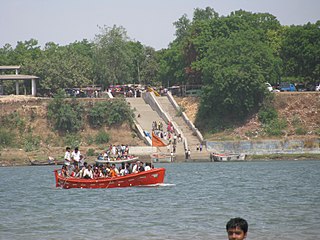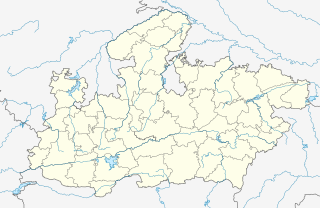 W
WThe Narmada River, also called the Reva and previously also known as Narbada (Nerbudda). It is also known as "Life Line of Madhya Pradesh and Gujarat" for its huge contribution to the state of Madhya pradesh and Gujarat in many ways. Narmada rises from Amarkantak Plateau in Anuppur district Madhya Pradesh. It forms the traditional boundary between North India and South India and flows westwards over a length of 1,312 km (815.2 mi) before draining through the Gulf of Khambhat into the Arabian Sea, 30 km (18.6 mi) west of Bharuch city of Gujarat.
 W
WBargi Dam is one of the first completed dams out of the chain of 30 major dams to be constructed on Narmada River in Madhya Pradesh, India Here Narmada fully Submerge Bargi River that It can't be seen as it exist or not. Two major irrigation projects, named Bargi Diversion Project and Rani Avantibai Lodhi Sagar Project, have been developed by Bargi Dam. The Narmada is the largest river in Madhya Pradesh, flowing towards the west and falling in the Arabian Sea. Its total length is 1312 km of which it covers 1072 km in Madhya Pradesh.
 W
WThe Golden Bridge connects Ankleshwar to Bharuch in the Gujarat state of western India. It was built in 1881 by the British, who needed a bridge across the Narmada River to create better access to trade and administration officials in Bombay. The bridge is also called the Narmada Bridge.
 W
WKabirvad is a banyan tree located on a small river island in Narmada river. It is Bharuch district, Gujarat, India. The tree and place is associated with 15th century mystic-poet Kabir. There is a temple dedicated to Kabir. It is believed that the banyan tree was sprouted from Datoon. The place is religious site as well as popular tourist spot.
 W
WMandhata, also called Shivapuri or Mahismati, Capital of Awanti Mahajanpad Omkareshwar, is a riverine island in the Narmada river in Khandwa district, Madhya Pradesh, India. Omkareshwar Jyotirlinga is situated on the southern part of the island. Omkareshwar Mandhata is located on the Mandhata hill on the banks of the Narmada.
 W
WNarmada Bachao Andolan (NBA) is an Indian social movement spearheaded by native tribals (adivasis), farmers, environmentalists and human rights activists against a number of large dam projects across the Narmada River, which flows through the states of Gujarat, Madhya Pradesh and Maharashtra. Sardar Sarovar Dam in Gujarat is one of the biggest dams on the river and was one of the first focal points of the movement. It is part of the Narmada Dam Project, whose main aim is to provide irrigation and electricity to people of the above states.
 W
WThe Narmada Canal is a contour canal in northwestern India that brings water from the Sardar Sarovar Dam to the state of Gujarat and then into Rajasthan state. The main canal has a length of 458 kilometres (285 mi) in Gujarat and then 74 kilometres (46 mi) in Rajasthan. The main canal is connected with 42 branches resulting in a Culturable Command Area (CCA) of 2,129,000 hectares.
 W
WNarmada Nagar is a township in Punasa Tehsil in East Nimar district of Madhya Pradesh, India. It belongs to Indore division.
 W
WNarmada Pushkaram is a festival of River Narmada normally occurs once in 12 years. This Pushkaram is observed for a period of 12 days from the time of entry of Jupiter into Vrushabha Rasi (Taurus).
 W
WNarmada Seva Yatra is a campaign by the government of Madhya Pradesh, India, to conserve the Narmada River. The campaign intends to create public awareness and involvement and promote activities such as soil conservation, water conservation, afforestation, pollution control, and organic farming.
 W
WThe Narmada Valley dry deciduous forests are a tropical dry forest ecoregion of central India. The ecoregion lies mostly in Madhya Pradesh state, but extends into portions of Chhattisgarh, Maharashtra, and Uttar Pradesh states.
 W
WThe Sardar Sarovar Dam is a concrete gravity dam built on the Narmada river in Kevadiya near Navagam, Gujarat in India. Four Indian states, Gujarat, Madhya Pradesh, Maharashtra and Rajasthan, receive water and electricity supplied from the dam. The foundation stone of the project was laid out by Prime Minister Jawaharlal Nehru on 5 April 1961. The project took form in 1979 as part of a development scheme funded by the World Bank through their International Bank for Reconstruction and Development, to increase irrigation and produce hydroelectricity, using a loan of US$200 million. The construction for dam begun in 1987, but the project was stalled by the Supreme Court of India in 1995 in the backdrop of Narmada Bachao Andolan over concerns of displacement of people. In 2000–01 the project was revived but with a lower height of 110.64 metres under directions from SC, which was later increased in 2006 to 121.92 meters and 138.98 meters in 2017. The dam was inaugurated in 2017 by Prime minister Narendra Modi. The water level in the Sardar Sarovar Dam at Kevadia in Narmada district reached its highest capacity at 138.68 metres on 15 September 2019.
 W
WReva: A Journey Within is a 2018 Gujarati adventure drama film starring Chetan Dhanani and Monal Gajjar produced by Brainbox Studios and Baroda Talkies. The film is based on Gujarati author Dhruv Bhatt's 1998 Gujarati novel Tatvamasi. The film was directed by Rahul Bhole and Vinit Kanojia. It was released on 6 April 2018 to positive critic reviews. The film won National Film Award for Best Feature Film in Gujarati at the 66th National Film Awards.
 W
WA River Sutra is a collection of stories written by Gita Mehta and published in 1993. The book's stories are interconnected by both a geographical reference, and by the theme of diversity within Indian society, both present and past. Unlike some of Mehta's previous stories, the ones in A River Sutra feature only Indian characters.
 W
WThe Sardar Sarovar Dam is a concrete gravity dam built on the Narmada river in Kevadiya near Navagam, Gujarat in India. Four Indian states, Gujarat, Madhya Pradesh, Maharashtra and Rajasthan, receive water and electricity supplied from the dam. The foundation stone of the project was laid out by Prime Minister Jawaharlal Nehru on 5 April 1961. The project took form in 1979 as part of a development scheme funded by the World Bank through their International Bank for Reconstruction and Development, to increase irrigation and produce hydroelectricity, using a loan of US$200 million. The construction for dam begun in 1987, but the project was stalled by the Supreme Court of India in 1995 in the backdrop of Narmada Bachao Andolan over concerns of displacement of people. In 2000–01 the project was revived but with a lower height of 110.64 metres under directions from SC, which was later increased in 2006 to 121.92 meters and 138.98 meters in 2017. The dam was inaugurated in 2017 by Prime minister Narendra Modi. The water level in the Sardar Sarovar Dam at Kevadia in Narmada district reached its highest capacity at 138.68 metres on 15 September 2019.
 W
WSaurashtra Narmada Avtaran Irrigation (SAUNI) is a project launched by Indian Prime Minister Narendra Modi with objective of filling 115 major dams by diverting floodwaters overflowing from the Sardar Sarovar Dam across the Narmada river to the drought areas.
 W
WThe Statue of Unity is a colossal statue of Indian statesman and independence activist Vallabhbhai Patel (1875–1950), who was the first Deputy Prime Minister and Home minister of independent India and adherent of Mahatma Gandhi during the non-violent Indian Independence movement. Patel was highly respected for his leadership in uniting 562 princely states of India with a major part of the former British Raj to form the single Union of India. The statue is located in the state of Gujarat, India. It is the world's tallest statue with a height of 182 metres. It is located on the Narmada River in the Kevadiya colony, facing the Sardar Sarovar Dam 100 kilometres (62 mi) southeast of the city of Vadodara and 150 kilometres (93 mi) from Surat.